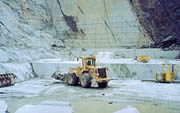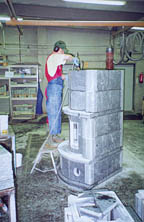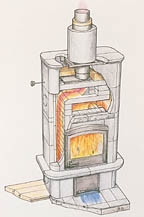

Mass production of Finnish soapstone dates back to the late 1800s, when it was quarried and cut by hand. The material was used for sculpture as well as major architectural commissions, and the stone's heat retention qualities made it a popular choice for residential fireplaces. The quarry in Juuka, which opened 1893, developed into a strong source of employment in the region. However, the era of technological development over the course of the 20th century led to electrical stoves, and the quarry was closed during the 1960s.
Around 20 years later, a renewed interest in natural building materials inspired Reijo Vauhkonen to reopen the quarry. Working with Makron Oy, a Finnish manufacturer of stoneworking equipment, they began producing material, and the company eventually took on the name, "Tulikivi," which literally means "fire/stone."
The soapstone is available from Tulikivi in three shades of gray -- including one with a distinctive bluish tint -- and four different finishes: polished, diamond calibrated, bushhammered and split-face for organic appeal. The fireplaces can be built with contrasting finishes, and they can also be complemented with green or black serpentine stone, quarried nearby in Eastern Finland.

The production process
Tulikivi Group operates five factories, including two for fireplaces, two for architectural work and one for OEM parts, such as curved pieces and other high-end elements for wood stove manufacturers. The main quarry and factories are in Juuka, and the company also operates a plant and quarries in Suomussalmi, located approximately 200 miles away. The company's two architectural stone factories manufacture granites in Taivassalo and Vinkkil?p>A total of 550 workers are employed by the company, up from 450 in 2000 and 250 in 1996. The quarries operate most of the year, typically closing from mid-December to mid-February. However, since the quarries are allowed to operate in temperatures as low as -25 degrees Centigrade, the 2000-2001 winter was mild enough to allow quarrying year round. The quarry is currently running three shifts, and the site is illuminated in the evening for night extraction. Annual production totals 40,000 cubic meters of soapstone each year (including the site in Suomussalmi), and Tulikivi consistently maintains a surplus block inventory of 5,000 cubic meters.The stone is freed from the quarry face with chainsaws, which cut both vertically and horizontally. The engine and saw mechanism are produced in Germany by Korfmann GmbH, and the equipment is heavily modified by Tulikivi's engineers, who create the structure, rails, cabin and hydraulics.
Each ledge within the quarry is 7 feet, 4 inches high, and the vertical cuts are made 6 feet from the edge of the ledge. As a result, blocks typically measure 7 feet high x 6 feet wide in size, and the length depends on the natural break within the quarry. A Caterpillar front loader, which can accommodate weights up to 44,000 pounds, is used to remove blocks from the quarry. The quarry yield is approximately 30% for fireplace production, and waste is taken from the quarry after each shift.
The original mill was built in 1980, and production began with 19 workers. Primary equipment for fireplace production includes a 12-foot Makron block saw and a Makron multi-blade saw, which cuts the material into panel sizes of 30, 60 and 90 mm thick. The stone is then calibrated to the proper width, and the edges are beveled. Also, slots are drilled into the sides of the stones as needed to allow for assembly into a fireplace.
The pieces then move to skilled stoneworkers, who cut and grind the stones to exacting dimensions, and then assemble the various fireplace models. Custom fireplaces are then disassembled, and the pieces are numbered for reassembly prior to shipment.
Each model is tested for safety, emissions and overall efficiency. For custom models, the company tests the basic internal system that will be used for the unit. Tulikivi produces a total of over 15,000 fireplaces each year, and an average fireplace weighs almost two tons.
In addition to fireplaces, the facilities in Juuka also produce tiles and various cut-to-size pieces. Equipment for this work includes Makron bridge saws, a CNC edging machine and a tile line.

Marketing efforts
In 2000, Tulikivi products were sold in 18 different countries around the world, including the U.S. Overall, the company's top export market is Germany. Sales grew by 20% in 2000, reaching a total of $46.9 million, with a total profit of $7.1 million. The same growth is expected for 2001.With an eye on maintaining future growth, the company invested an additional $5 million in various upgrades in 2000, and the company seeks to either purchase or build a new factory every two years.
Tulikivi also hopes to maintain a pattern of growth by expanding the scope of its operations. Two years ago, the management at Tulikivi decided to move beyond production of soapstone and fireplaces, and to delve into fabrication of other materials for architectural projects. With this decision, Tulikivi Architectural Stone was born, manufacturing Finnish and Scandinavian granites as well as soapstone. The company purchased one of the leading production units in Scandinavia, and it is involved with customers on all phases of a project, from quarrying to fabrication to installation, as it also operates its own stone installation company.
Products fabricated by Tulikivi Architectural Stone include materials for interior design, such as flooring and countertops; stone for landscape applications, and semi-finished good such as slabs. Tulikivi Group is now among the five largest stone producers is Europe.

Sidebar - The concept behind a soapstone fireplace
The working principles behind a soapstone fireplace, which operates through thermal mass heating, are quite different from a traditional open fireplace, where heat escapes through a chimney. Because soapstone retains heat and conducts it quickly, the stone itself serves as an efficient thermal mass heater, and not the actual flame. Essentially, the fireplace heat is captured in the mass of the soapstone and released slowly and evenly over time, even long after the fire goes out. Tulikivi engineers point out that a small amount of wood used for an initial firing provides a gentle stream of radiant heat for periods up to 24 hours. But even though the entire stone exterior generates radiant heat, it is safe to touch.Additionally, the fireplaces offer the option to incorporate a set of electrical heating elements, which maintains the soapstone mass at a set temperature without the need for a fire.
For the U.S. market, Tulikivi offers a total of 13 basic fireplace models, including ones with bake ovens and cooktops. Beyond the standard fireplaces, there are designs by the internationally known Finnish architect, Eliel Saarinen, from the turn of the century. There is also a Forma Europa line of architectural styles for contemporary settings. Most of the fireplaces are built based on existing designs, although 20% of the company's work is custom, particularly for the U.S. market.
Fireplaces are assembled on-site by a qualified installer certified by Tulikivi, who also provides follow-up care instructions. In the U.S., there are 10 distributors which are certified to install Tulikivi fireplaces, with a total 40 certified installers. The price for consumers is as low as $4,500 for a more basic model, although the average product cost is around $10,000.